英语短篇小说教程电子教案-Unit2
- 格式:ppt
- 大小:91.00 KB
- 文档页数:12
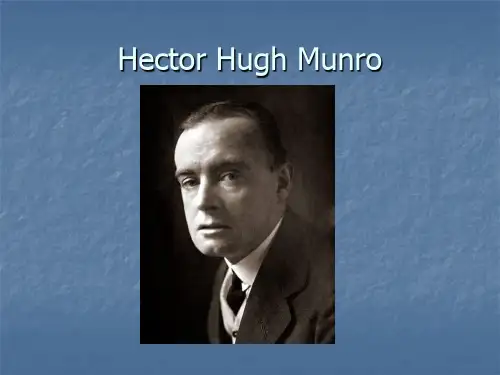
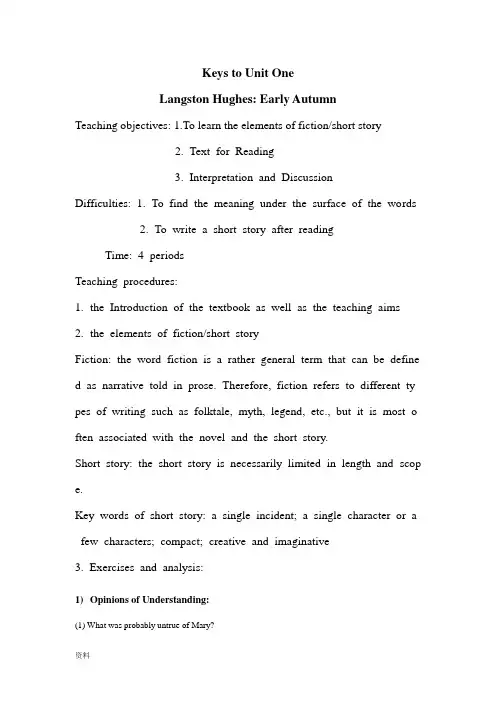
Keys to Unit OneLangston Hughes: Early AutumnTeaching objectives: 1.To learn the elements of fiction/short story2. Text for Reading3. Interpretation and DiscussionDifficulties: 1. To find the meaning under the surface of the words2. To write a short story after readingTime: 4 periodsTeaching procedures:1.the Introduction of the textbook as well as the teaching aims2.the elements of fiction/short storyFiction: the word fiction is a rather general term that can be define d as narrative told in prose. Therefore, fiction refers to different ty pes of writing such as folktale, myth, legend, etc., but it is most o ften associated with the novel and the short story.Short story: the short story is necessarily limited in length and scop e.Key words of short story: a single incident; a single character or a few characters; compact; creative and imaginative3. Exercises and analysis:1)Opinions of Understanding:(1) What was probably untrue of Mary?A. She missed the days of the past.B. She still loved Bill.C. She worked to keep a family of three children.D. She was satisfied with her life and job in New York.(2) Which of the following adjectives can probably best describe Bill’s attitude?A. Emotional.B. Indifferent.C. Puzzled.D. Hopeful.(3) Mary didn’t say anything when she got on the bus. Why?A. She had nothing more to say.B. She was disappointed in Bill.C. She was too emotional.D. She knew the situation was hopeless.(4) The last sentence of the story “she had forgotten …to tell him that her youngest boy was named Bill, too” shows that ________.A. Mary knew she would meet Bill again some day.B. “Bill” is a very common name.C. Mary had been thinking about Bill and still loved him.D. Mary was proud of her youngest son.(5) The title of the short story “Early Autumn” may suggest to the reader that _______.A. the bitterness of an emotional long winter was aheadB. it was still the bright time of one’s life, like early AutumnC. both Mary and Bill were now middle-aged peopleD. the love between them was not as “hot” as summer days2) Questions for Discussion(Suggested answers for reference):(1) Can you pick out words and sentences to show that Mary and Bill were now different in their attitudes toward each other?1) Mary: …she saw him for the first time in years. (line 5)Bill: At first he did not recognize her… (line 8)2) Mary: Unconsciously, she lifted her face as though wanting a kiss… (line 11)Bill: …but he held out his hand. (line 12)3) Mary: “I live in New York now,” she said. (eagerly telling him her address) (line 14)Bill: “Oh” – smiling politely, then a little frown came quickly between his eyes. (having no interested in her living place now.) (lines 15-16)4) Mary: “Married yet?” (concerning keenly about his marital status) (line 21)Bill: “Sure. Two kids.”(being satisfied with his present situation and showing pride in mentioning his family.) (line 22)5) Bill: “And your husband?” he asked her. (not noticing her subtle emotional change.) (line 27)Mary: “We have three children. I work in the bursar’s office at Columbia” (avoiding mentioning her husband in her reply). (line 28)6) Bill: “You’re looking very …” (he wanted to say old) “… well,” he said. (not being sensitive to her condition.) (line 29)Mary: She understood. (being very sensitive to her own condition.) (line 30)7) Mary: “We live on Central Park West,” she said. “Come and see us sometime.”(offering a direct invitation.) (line 33)Bill: “Sure,” he replied. “You and your husband must have dinner with my family some night. Any night. Lucille and I’d love to have you.”(giving a polite indirect rejection.) (lines 34-35)8) Mary: “There’s my bus,” she said. (line 42)Bill: He held out his hand, “Good-by.” (ready to part with Mary.) (line 43)Mary: “When …” she wanted to say… (not ready to part with Bill) (line 44)(2) Several times the author describes the scene on Washington Square: the dusk, the chilly weather, the falling leaves, the passing people. Does he only want to tell us where and when the story takes place? What other effects do such descriptions achieve?(The description of the setting gives the reader a feeling of sadness and depression. It was getting dark and getting cold with leaves falling. The bright daytime was over and the unpleasant darkness was ahead, and the warm and comfortable summer and early autumn days were being replaced by the cold and long winter. The setting echoes and reinforces Mary’s feelings of regret and yearning and implies the emotional crisis that she might have to face.)3) Explanation and Interpretation:(Explain the implied meaning of the following sentences, and point out their significance in the context of the story.)1) Impulsively, she had married a man she thought she loved.(Notice the two key words: “impulsively”and “thought.”This has direct relation to her reactions at Washington Square, New York, years later. She made an impulsive decision and the man she “thought” she loved was not the man she wanted to be a life partner with.)2) Unconsciously, she lifted her face as though wanting a kiss, but he held out his hand.(Her unconscious reaction reveals that their sweet love in the past had been kept alive in Mary’s memory for all these years, but Bill had undergone a total change, treating her as an ordinary acquaintance of the past.)3) “And your husband?” he asked her.“We have three children. I work in the bursar’s office at Columbia.”(This is the first time Bill initiated the conversation, but he had failed to notice the signs in Mary’s emotional reaction and asked a question he should have not asked. Mary avoided the question by talking about something else. Why did she avoid mentioning her husband? There is message in the avoidance.)4) The lights on the avenue blurred, twinkled, blurred.(The vision came from Mary’s eyes. Obviously, her eyes were now filled with tears.)5) The bus started. People came between them outside, people crossing the street, people theydidn’t know. Space and people.(A lot of people had walked into their lives, Mary and Bill’s family members and their respective circle of friends and colleagues. It was no longer their world of two young lovers when they were in Ohio.)4) Suggested Homework:Suppose you were Bill Walker and you had a habit of writing down what happened to you in your diary. After the chance meeting with Mary at Washington Square, you went home and wrote a brief paragraph about the meeting. The paragraph may begin like this:Oct. 11, 2009I had never expected to see Mary, but I met her at Washington Square. She looked rather old to me – I didn’t even recognize her immediately…For reference only:Oct. 11, 2009(I had never expected to see Mary, but I met her at Washington Square. She looked rather old to me – I didn’t even recognize her immediately. It was quite a surprise that she could pick me out among the hustling and bustling crowd in the street. After all, it has been quite a few years since we parted -- Eight, nine, or ten years? Time flies and we both changed a lot, no longer the heady, impulsive kind of youngsters that we once were. For some reason, she seemed rather emotional about this chance meeting, and was keen in knowing about what had happened to me in these years and in telling and inviting me to her place. Somehow, she avoided mentioning her husband, the man she quickly married after we ran into a little problem in our relationship. Ten years is a long time, enough to reshape a person’s life. I wish her and her family all the happiness, sincerely.)Keys to Unit Two(1) I. B. Singer: The Washwoman(2) Frank Sargeson: A Piece of Yellow Soap1) Questions for Discussion:(Suggested answers for reference)(1) Does the piece of washing soap have the “power” as the narrator tells us? What is the “power”that forces him to take off?(The piece of yellow washing soap is, of course, an ordinary one. The narrator is a “naïve narrator”who believed that it had some sort of mysterious “power,”while the readers are expected to know better. This power comes from the narrator’s deep sympathy for the tragic fate of the washing woman. Seeing the situation, he simply could not continue to demand the payment which he knew the woman was unable to produce.)(2) In this Unit, we have two stories about two washwomen. There are a lot of similar descriptionsand common characteristics in the two stories. Find and list them.(They were both reduce to desperation, depending solely on washing for living. Both were hard-working and uncomplaining, quietly but almost heroically bore their burden and struggled for a hard existence. The author describes their common feature –the white and shrunken fingers – as symbol of suffering in the lives of the working people. They both were both dead by the end of the stories.)(3) The two first-person narrators tell two stories of two washwomen who shared similar tragicfate. Discuss the differences in the narrators that result in the differences in the way the two short stories are told.(Singer’s narrator knows more and tells more about the washing woman, often making direct comments and revealing his own feelings about the life of the woman whose story he is telling. He frequently emphasizes that what he is telling is real, and hints that the story has significance. The narrator’s voice is very close to the author’s. Please see more in “Reading Tips” on page 11. On the other hand, Sargeson’s narrator is a naïve one, that is, the narrator’s understanding is purposely made shallow, and the reader need find by himself the real meaning in the situation. So the narrator stands at some distance from the author. Please see more in “Reading Tips”on page 15. Therefore, in Text I, we, as readers, are basically “given” or “received” the story, while in Text II, we need to participate imaginatively in the story to “dig out” the true meaning the naïve narrator has left unexplained.)2) Explanation and Interpretation:(Explain the implied meaning of the following sentences, and point out their significancein the context of the story.)From “The Washwoman”:(1) She had been so sick that someone called a doctor, and the doctor had sent for a priest.(According to the custom, a priest should be present while one is dying. The implied message is the doctor thought that he could do nothing to save her, and the best thing to do was to prepare for her death.)(2) “With the help of God you will live to be a hundred and twenty,” said my mother, as ablessing.“God forbid!...”(“My Mother” extended a good wish for long life to her, but the washing woman thought that a long life was a terrible thing, because it only meant suffering longer.)(3) Her soul passed into those spheres where all holy souls meet, regardless of the roles theyplayed on this earth, in whatever tongue, of whatever religion.(A good person, like the old washwoman, would go to heaven because she had a noble soul.She would rise above all the earthly considerations of class, race, nation and religion. )From “A Piece of Yellow Soap”:(4) My eyes would get fixed on her fingers and the soap, and after a few minutes I would lose allpower to look the woman in the face. I would mumble something to myself and take myself off .(The narrator could not bear to look at this washing-tub slave for too long. He would have to find some excuse and leave. He could not push her over the cliff while she was standing on the verge of total desperation.)(5) She had a way too of feeling inside her handbag as she passed me, and I always had the queerfeeling that she carried there a piece of soap. It was her talisman powerful to work wonders…(Possibly in the bag there were a few pennies that the woman had earned from her washing, and she was going to buy food or some necessities. Seeing the narrator, to whom she knew she owed money, she unconsciously or protectively put her hand in the bag. The narrator, being “naïve,” misunderstood her reaction while they met in the street.)Suggested Homework:Translate the following paragraphs from “The Washwoman” into Chinese:The bag was big, bigger than usual. When the woman placed it on her shoulders, it covered her completely. At first she stayed, as though she were about to fall under the load. But an inner stubbornness seemed to call out; no, you may not fall. A donkey may permit himself to fall under his burden, but not a human being, the best of creation.She disappeared, and mother sighed and prayed for her.More than two months passed. The frost had gone, and then a new frost had come, a new wave of cold. One evening, while mother was sitting near the oil lamp mending a shirt, the door opened and a small puff of steam, followed by a gigantic bag, entered the room. I ran toward the old woman and helped her unload her bag. She was even thinner now, more bent. Her head shook from side to side as though she were saying no. She could not utter a clear word, but mumbled something with her sunken mouth and pale lips.For reference only:衣服包很大,比平时更大。
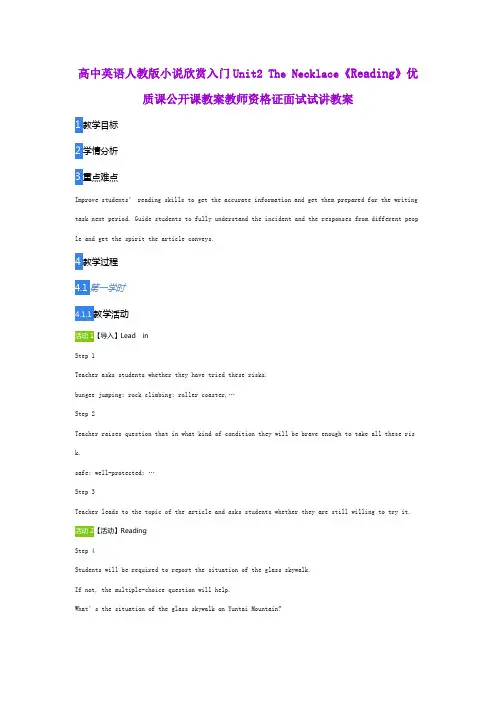
高中英语人教版小说欣赏入门Unit2 The Necklace《Reading》优质课公开课教案教师资格证面试试讲教案1教学目标2学情分析3重点难点Improve students’ reading skills to get the accurate information and get them prepared for the writing task next period. Guide students to fully understand the incident and the responses from different peop le and get the spirit the article conveys.4教学过程4.1第一学时教学活动1【导入】Lead inStep 1Teacher asks students whether they have tried these risks.bungee jumping; rock climbing; roller coaster,…Step 2Teacher raises question that in what kind of condition they will be brave enough to take all these ris k.safe; well-protected; …Step 3Teacher leads to the topic of the article and asks students whether they are still willing to try it.2【活动】ReadingStep 4Students will be required to report the situation of the glass skywalk.If not, the multiple-choice question will help.What’s the situation of the glass skywalk on Yuntai Mountain?。
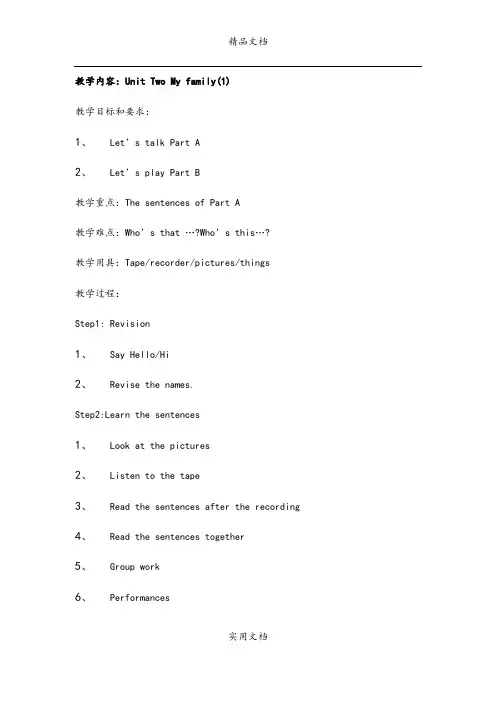
教学内容:Unit Two My family(1)教学目标和要求:1、Let’s talk Part A2、Let’s play Part B教学重点:The sentences of Part A教学难点:Who’s that …?Who’s this…?教学用具:Tape/recorder/pictures/things教学过程:Step1: Revision1、Say Hello/Hi2、Revise the names.Step2:Learn the sentences1、Look at the pictures2、Listen to the tape3、Read the sentences after the recording4、Read the sentences together5、Group work6、PerformancesStep3: Let’s play1、 Try to introduce someoneStep4: Listen and doStep5: Summary and homework板书设计:Unit 2 My familyFather mother man woman 作业布置:1、Listen to the tape2、Read the sentences教学后记:教学内容:Unit Two My family (2)教学目标和要求:1、Learn the new words2、Try to listen and touch教学重点:the new words教学难点:Let’s do教学用具:Tape/recorder/pictures/things教学过程:Step1: Revision1、Greetings2、Introduce someoneStep2: Learn the new words1、Look at new pictures.2、Learn the new words3、Listen to the tape4、Read the new words5、Guessing gameStep3: Let’s do1、Look at the picture2、Listen and doStep4: Summary and homework板书设计:Unit 2 My familyWho’s this man?He’s my father.作业布置:1、Listen to the tape2、Read the words教学后记:教学内容:Unit Two Look at me(3)教学目标和要求:1、Let’s draw2、Sing the song3、Learn Part B: Let’s talk教学重点:Let’s talk and Let’s sing 教学难点:afternoon 的发音教学用具:Tape/recorder/pictures/things 教学过程:Step1: Revision1、Touch your…2、Good morning/Nice to meet you!Step2: Learn the sentences of Part B1、Look at the pictures2、Listen to the tape3、Read the sentences4、Read the sentences5、Perform the dialogueStep3: Let’s p lay1、Look at the pictures2、Read the sentences3、Play the game with your partner. Step4:Sing the Teddy bear song1、Read the words2、Listen to the tape3、Sing the song4、Sing and doStep5:Summary and homework板书设计:Unit 2 My familyWho’s this boy? He’s my brother.作业布置:1、Listen to the tape2、Read the sentences3、Sing the song教学内容:Unit Two My family (4)教学目标和要求:1、Learn the new words2、Let’s do and chant教学重点:The new words教学难点:The new words教学用具:Tape/recorder/pictures/things教学过程:Step1: Revision1、Greetings2、Le t’s doStep2: Learn the new words1、Look at the toy2、Say out the words3、Look and say4、Listen to the recording5、Listen and doStep3: Let’s do1、Look at the pictures2、Listen to the tape3、Let’s doStep4:Let’s chant1、Listen to the tape2、Say and doStep5:Summary and homework板书设计:Unit 2 My familyCome on.Who’s this boy?He’s my brother.作业布置:1、Listen to the tape2、Read the words教学后记:教学内容:Unit Two My family(5)教学目标和要求:1、Try to understand the meaning of the story tome2、Try to know the culture.3、Let’s check教学重点:Story tome; Culture;Let’s check教学难点:Let’s check教学用具:Tape/recorder/pictures/things教学过程:Step1: RevisionStep2: Story time1、Look at the pictures2、Listen to the recording3、Read the sentences after the recording4、Try to understand the meaning of story5、Read the storyStep3: To know culture1、Look at the pictures2、The culture of HalloweenStep4:Let’s sing1、Listen to the recording2、Read the words of the song3、Sing the song after the recording4、Sing the song togetherStep5:Summary and homework板书设计:Unit 2 My familyHow beautiful.作业布置:1、Listen to the tape2、Sing the song教学后记:。
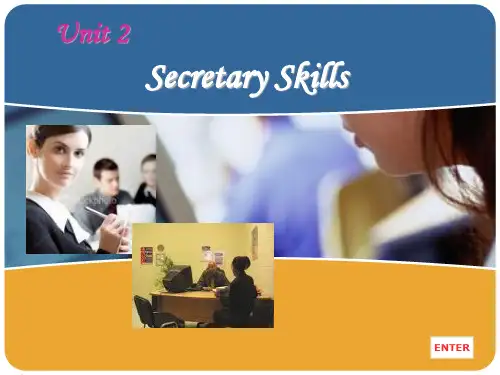
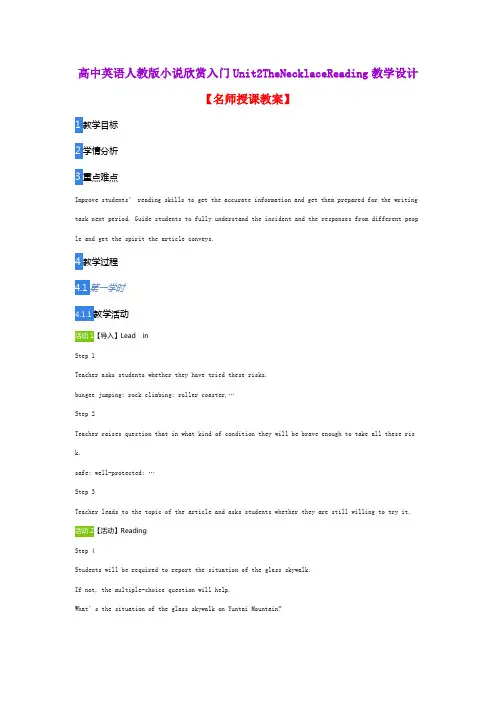
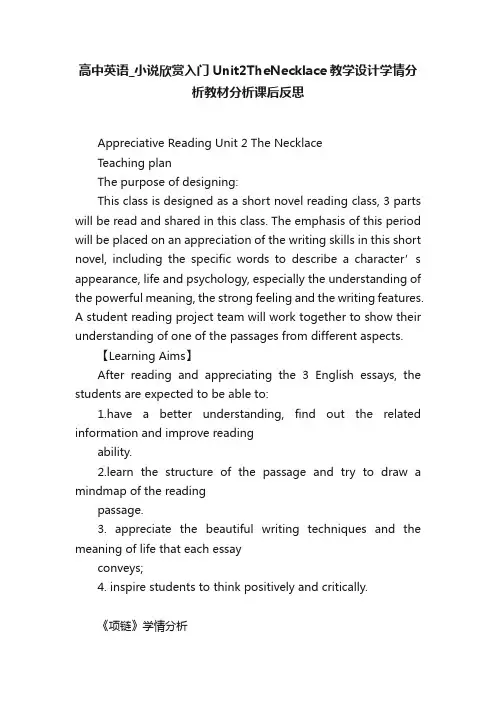
高中英语_小说欣赏入门Unit2TheNecklace教学设计学情分析教材分析课后反思Appreciative Reading Unit 2 The NecklaceTeaching planThe purpose of designing:This class is designed as a short novel reading class, 3 parts will be read and shared in this class. The emphasis of this period will be placed on an appreciation of the writing skills in this short novel, including the specific words to describe a character’s appearance, life and psychology, especially the understanding of the powerful meaning, the strong feeling and the writing features.A student reading project team will work together to show their understanding of one of the passages from different aspects.【Learning Aims】After reading and appreciating the 3 English essays, the students are expected to be able to:1.have a better understanding, find out the related information and improve readingability.2.learn the structure of the passage and try to draw a mindmap of the readingpassage.3. appreciate the beautiful writing techniques and the meaning of life that each essayconveys;4. inspire students to think positively and critically.《项链》学情分析一、学生学情分析高二1班、共有55人,为年级B班。
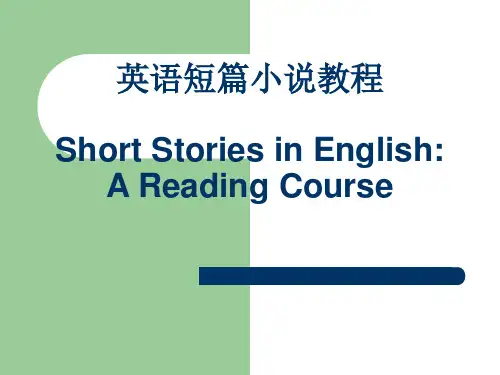

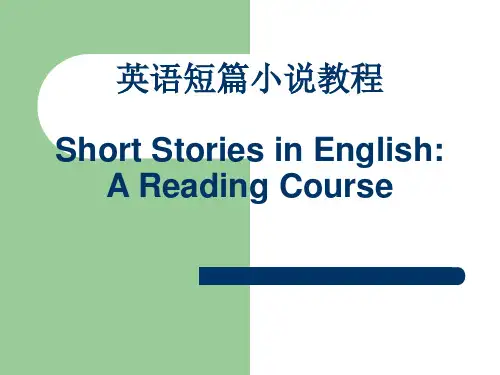
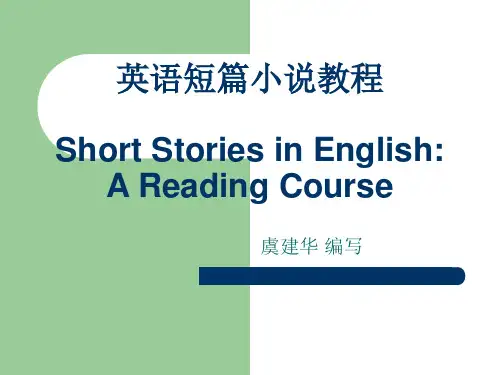
Unit2 The ELVES AND THE SHOEMAKER教学内容:六年级小学英语课外阅读教材Unit2 The elves and the shoemaker教学目标:1.能听懂故事、理解故内容。
2.能用简短的单词或句子表达自己的一些意愿或想法。
3.掌握英语课外阅读的一些小技巧。
4.学会感恩、学会同伴间互相帮助。
教学重、难点:1.能听懂故事、理解故内容。
2.能用简短的单词或句子表达自己的一些意愿或想法。
教学准备:PPT 录音教学流程:Step1: Greeting.T: Are you ready?S: Yes.T: Class begins.Step2: Free talk.Step3: Presentation.1.T: OK! I’m glad to make friends with you . Today let’s meet two new friends, OK? Let’s see who are they?(图片)揭题:Unit2 The elves and the shoemaker(板书)(带领学生学习elve 和shoemaker 这两个单词,要求能认,会读)2. T: First, let’s enjoy the story about The elves and the shoemaker.(观看视频动画)3. T: Do you like the story?Ss:…T: Read the story by yourselves , try to think and find the Chinese meaning.(学生结合书后生词表,朗读并理解课文大概意思)4:.T:Let’s play a game.(检查学生自学的情况)(Roles: If it is right, you can say : Yeah, Yeah, Yeah, if it is wrong , you can say: No, No, No)( 1 ) A long time ago,there lived a very rich shoemaker.( 2 ) The customer liked the shoes very much,but he didn’t buy them.( 3 ) The shoemaker and his wife decided to stay up and see who hadbeen helping them make shoes.(4)After the shoemaker became rich,he never helped his neighbours.(5)The shoemaker and his wife made some beautiful shoes for the elves.T总结:Reading tips阅读中,遇到生词,我们可以: 1. 查生词表。
☆☆☆☆☆☆☆☆☆☆☆☆☆☆☆☆☆☆☆☆☆☆☆☆☆☆☆☆☆☆☆☆☆☆☆☆☆☆☆☆☆☆☆☆☆☆☆☆☆☆☆☆☆☆☆☆☆☆☆☆☆☆☆Unit 2 Periphery Device【教学目的】○ Learn about the English terms of the periphery devices of the computer, including drive, bus, inkjet printer, modem, PCI, plug & play, CD-ROM, Hard drive, vidio-card, printer, scanner, sound card,○ Improve the students’ ability to understand the long and difficult sentences in Text A and Text B.○ Master the key language points and grammatical structures in the text.○ consolidate the technical terms and important professional phrases by doing exercises. 【教学重点难点】○Important technical terms:zip drive (压缩驱动器), CD-ROMs (CD光盘), DVD-ROMs (DVD光盘), analog signals (模拟信号), digital signal (数字信号), electronic filing cabinet (电子档案柜), bubble jet ○ Abbreviation:CD-ROM, DVD-ROM, PCI, ISA, PCMCIA, CMOS, BIOS;○Difficult sentences:1. A modem modulates outgoing digital signals from a computer or other digital device to analog signals over a conventional telephone line and demodulates the incoming analog signal and converts it to a digital signal for the digital device (computer). Mo-dem = modulate + demodulate2. Peripheral Component Interconnect (PCI) is an interconnection system between a microprocessor and attached devices in which expansion slots are spaced closely for high speed operation.○Review the important points of essential English1. be meant to do sth. 设计成做某事例句:Function keys are meant to perform user-defined tasks.2. have sth. done例句一:A device for storing and/or retrieving data. Some drives (such as disk drives, zip drives, and tape drives) are typically capable of having new data written to them例句二:A standard that gives computer users the ability to plug a device into a computer and have the device recognized automatically.【教学步骤】Step OneRead and explain Text A to the students and ask the students to keep in mind the following professional terms:1)zip drive (压缩驱动器)A high-capacity floppy disk drive developed by Iomega Corporation. Zip disks are slightly larger than conventional floppy disks, and about twice as thick. They can hold 100 or 250 MB ofdata. Because they're relatively inexpensive and durable, they have become a popular media for backing up hard disks and for transporting large files.2)CD-ROM(CD光盘)Pronounced see-dee-rom. Short for C ompact D isc-R ead-O nly M emory, a type of optical disk capable of storing large amounts of data -- up to 1GB, although the most common size is 650MB (megabytes). A single CD-ROM has the storage capacity of 700 floppy disks, enough memory to store about 300,000 text pages.CD-ROMs are stamped by the vendor, and once stamped, they cannot be erased and filled with new data. To read a CD, you need a CD-ROM player. All CD-ROMs conform to a standard size and format, so you can load any type of CD-ROM into any CD-ROM player. In addition, CD-ROM players are capable of playing audio CDs, which share the same technology.CD-ROMs are particularly well-suited to information that requires large storage capacity. This includes large software applications that support color, graphics, sound, and especially video.3) DVD-ROM(DVD光盘)A new type of read-only compact disc that can hold a minimum of 4.7GB (gigabytes), enough for a full-length movie.The DVD-ROM specification supports disks with capacities of from 4.7GB to 17GB and access rates of 600 KBps to 1.3 MBps. One of the best features of DVD-ROM drives is that they are backward-compatible with CD-ROMs. This means that DVD-ROM players can play old CD-ROMs, CD-I disks, and video CDs, as well as new DVD-ROMs. Newer DVD players can also read CD-R disks.DVD-ROMs use MPEG-2 to compress video data.4)analogu(模拟)& digital(数字)Also spelled analogue, describes a device or system that represents changing values as continuously variable physical quantities. A typical analog device is a clock in which the hands move continuously around the face. Such a clock is capable of indicating every possible time of day. In contrast, a digital clock is capable of representing only a finite number of times (every tenth of a second, for example). In general, humans experience the world analogically. Vision, for example, is an analog experience because we perceive infinitely smooth gradations of shapes and colors.When used in reference to data storage and transmission, analog format is that in which information is transmitted by modulating a continuous transmission signal, such as amplifying a signal's strength or varying its frequency to add or take away data. For example, telephones take sound vibrations and turn them into electrical vibrations of the same shape before they are transmitted over traditional telephone lines. Radio wave transmissions work in the same way. Computers, which handle data in digital form, require modems to turn signals from digital to analog before transmitting those signals over communication lines such as telephone lines that carry only analog signals. The signals are turned back into digital form (demodulated) at the receiving end so that the computer can process the data in its digital format.5)bubble jet printer (气泡喷墨打印机)气泡喷墨打印机是由佳能所开发的一种喷墨印表技术,与一般压电式喷墨印表方式不同的是, 气泡喷墨打印机使用特殊加热装置产生墨点。
Unit 2 Write a Short Message教学设计Unit 2 Write a Short Message学习导学案班级:姓名:学习目标:1.知识目标:(1)了解短消息写作的要素。
掌握短消息、短文的书写格式以及模板。
(2)学会书本中出现的greeting, date, topic, closing, message等单词的中文意思,英文读音以及书写中相应位置和内容。
2.能力目标:(1)学生能分辨出短消息、短文写作的要素和内容。
(2)学生能在半开放的模板中书写短消息。
(3)学生能在单独完成一篇短消息的书写。
3.情感目标:(1)学生能相互合作完成小组学习任务,克服写作的心理障碍。
(2)体会出在英文短消息和中文的区别和联系。
一、根据微课写出单词的中文意思,并学会英语的读法。
greeting datetopic closingmessage remind sb. about sth.二、读会P28页中文文章,在云教育系统中完成。
三、思考一下中文短文写作的要素是什么?并调查英语短文写作的要素是什么?三、模板写作。
__________Dear ______,This is to remind you _____________________________________________.I’ll meet you _____________________ _______________________________ Don’t forget to ___________________.See you there!________四。
课后作业:开放式写作。
题目:请在前一天写一张便条提醒你的同学John,于3月12日上午9点,在人民公园参加植树活动(tree-planting activity),提醒他记得带好铲(shovel)和水桶(bucket)。
要求:1. 字数不低于40词。
2. 必须包含所有内容。